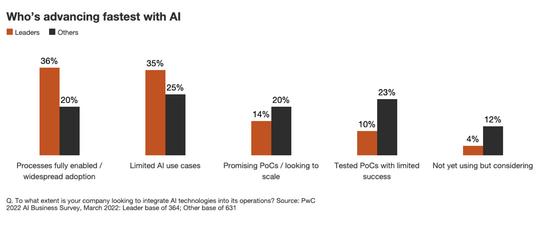
Artificial intelligence (AI) success is becoming the rule, not the exception. In PwC’s fourth annual AI business survey, most companies working with AI report results: promising proof of concepts that are ready to scale, or active use cases, or even widespread adoption of AI-enabled processes. But some companies stand out. They’re far more likely to be advanced in their AI usage and to be achieving valuable business outcomes — ones that produce not just a functioning AI model, but also significant ROI.
What sets these leaders apart, the data indicates, is their comprehensive approach. Rather than focusing first on one goal, then moving onto the next, they’re advancing with AI in three areas at once: business transformation, enhanced insights and decision making, and modernized systems and processes.

An approach to AI initiatives that encompasses business, technology and decision-making priorities helps data, AI and cloud work together smoothly, end-to-end. This unified approach to AI also aligns well with a unified approach to data, making a person (such as a chief data officer) or a centralized team responsible for data sharing and data governance. That can help connect data to AI in ways that benefit as many lines of business as possible. Thirty-six percent of companies with a comprehensive approach to AI are planning to use AI this year to help create a data fabric: an action-ready, 360 view of all data that touches their organizations.
Strategies AI leaders can focus on to help deliver valuable, real-world outcomes
1. Think better, faster, longer-term: Make decisions with AI support. AI-supported decision making is so powerful for a simple reason: It can enable you to incorporate and analyze far more information than you (or any human being) could do on their own. To help optimize pricing, for example, AI can input reams of historical data on product sales, margins, supplier costs and customer satisfaction, then produce rigorous estimates of different possible future scenarios. It can even forecast how competitors and suppliers might change their own prices in response to your decisions.
2. Simulate everything: Seize AI’s virtual power. It’s close to unanimous: 96% of survey respondents plan to use AI simulations, such as digital twins, this year. AI simulations are so powerful, because they can do more than provide detailed, real-time insights into current performance. They can increase the speed and lower the risk of your future operations. By modeling large numbers of different scenarios in parallel, simulations let you quickly forecast likely events and “game out” your best real-world actions before you take any real-world risks. When you bring together (for example) simulations of suppliers, customers, competitors and the weather, you can better predict supply chain pricing dynamics and disruptions — and have a plan in place to navigate them before they occur.
3. Put a number to it: Assess and predict AI’s ROI. AI has long had a grave problem for business: a lackluster return on investment (ROI). Companies were building AI models that worked, but which didn’t focus on the right business problems. This problem has grown more acute as companies advance beyond “boring AI” — with its often immediately attractive returns — to more sophisticated use cases. The more complex the challenge, the more important that business leaders work to aim their AI initiatives at the right problem. One main reason for this difficulty has been the challenge in measuring or even defining AI’s ROI. How, for example, do you quantify the value of a better strategic decision? Or how do you put a precise price on that supply chain disruption that never took place, because AI models gave you advance warning?
By deploying these methods well, they can be part of your foundation for sustainable, long-term growth. Read the full PwC survey here to learn the other strategies that can help you become an AI and analytics leader that achieves success.
